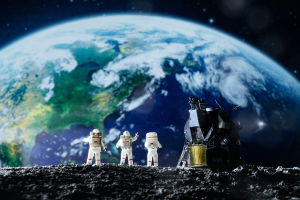Quantum Wonders Explained
We've all heard the term "quantum mechanics" thrown around, but how many of us truly understand it?
Quantum mechanics, often described as the science of the very small, reveals a world where particles behave in ways that defy our classical understanding of physics.
From particles being in multiple places at once to seemingly "spooky" actions across distances, the quantum realm is a strange place, and it's fundamental to everything we know. Let's dive in and explore this mysterious world together!
What is Quantum Mechanics?
At its core, quantum mechanics is the branch of physics that deals with the behavior of particles at the smallest scales—atoms and subatomic particles. Unlike objects we can see and touch in the everyday world, these particles don't follow predictable paths. Instead, they exist in a state of probability until they are measured. This "probability cloud" behavior is one of the most fascinating aspects of quantum mechanics.
We've all seen how larger objects, like cars or airplanes, follow predictable paths, which makes sense according to classical physics. But in the quantum world, particles such as electrons can be in more than one state or place at the same time! This is known as superposition. It's like saying a coin is both heads and tails while it's in the air, and only when it lands do we know its true state.
The Uncertainty Principle
One of the most mind-boggling principles in quantum mechanics is Heisenberg's Uncertainty Principle. This principle tells us that we can never simultaneously know both the position and momentum (speed and direction) of a particle with absolute certainty. The more precisely we try to measure one, the less precisely we can measure the other.
Imagine trying to take a perfect photo of a fast-moving car. The faster the car moves, the blurrier the picture becomes, and the less accurately you can capture its precise location and speed. In the quantum world, this blur is a fundamental feature of how particles behave, and it applies to all quantum systems.
Quantum Entanglement: Spooky Action at a Distance
Now, let's explore one of the weirdest aspects of quantum mechanics: quantum entanglement. Albert Einstein famously called it "spooky action at a distance," and for good reason! Quantum entanglement occurs when two particles become linked in such a way that the state of one particle is directly related to the state of the other—no matter how far apart they are.
This means that if you change the state of one particle, the other particle's state will change instantaneously, even if they're on opposite sides of the universe! Sounds like science fiction, doesn't it? But experiments have confirmed this phenomenon, and scientists are still trying to understand the deeper implications.
The Role of Observation: Why Does Measurement Matter?
In classical physics, we can measure the properties of an object without disturbing it. But in quantum mechanics, the very act of measuring a particle affects its behavior. This is known as the observer effect. When we observe a particle, it "decides" its position and other properties. Before that, it exists in a superposition of possibilities.
This leads us to one of the most famous thought experiments in quantum mechanics: Schrödinger's cat. In this scenario, a cat in a box is simultaneously alive and dead until someone opens the box and observes the state of the cat. Although this experiment is theoretical, it's a way to illustrate the strange effects of quantum measurement and observation.
Quantum Mechanics and Modern Technology
While quantum mechanics may seem like an abstract concept far removed from everyday life, its principles are at the heart of some of the most important technological advancements of our time. Quantum mechanics has led to the development of technologies like lasers, MRI machines, and even the computers and smartphones we rely on daily.
One exciting frontier is quantum computing. Unlike classical computers, which process information in binary (0s and 1s), quantum computers use quantum bits, or qubits, which can exist in multiple states at once. This could potentially allow quantum computers to solve complex problems far more efficiently than traditional computers, revolutionizing fields like cryptography, artificial intelligence, and drug discovery.
The Future of Quantum Mechanics
As we continue to study quantum mechanics, we uncover more mysteries about the universe. Researchers are exploring how quantum principles can explain phenomena like dark matter and dark energy, which make up the majority of the universe's mass but remain largely invisible and mysterious. The more we learn, the closer we come to unlocking the full potential of quantum mechanics—and understanding the deep connection between the smallest particles and the entire cosmos.
We may not fully grasp all the implications of quantum mechanics yet, but one thing is clear: this strange and fascinating field will continue to challenge our perceptions and open new doors to scientific discovery. Who knows what discoveries lie ahead?
Conclusion: A New Frontier for All of Us
Quantum mechanics is both a challenge and an invitation. It pushes us to rethink everything we know about the universe, from the smallest particles to the vast stretches of space. As we continue to explore this fascinating realm, it's crucial to remain curious and open to the possibilities it offers. After all, the mysteries of quantum mechanics might hold the keys to some of the most profound answers about the nature of reality itself.
We hope this brief journey through the world of quantum mechanics has sparked your curiosity. The more we learn, the more we realize how much there is to discover. What other mysteries of the universe are out there waiting for us to unlock?
Contact to : xyjph123@gmail.com
Privacy Agreement
Copyright © boyuanhulian 2020 - 2022. All Right Reserved.
Privacy Agreement
Copyright © boyuanhulian 2020 - 2022. All Right Reserved.


